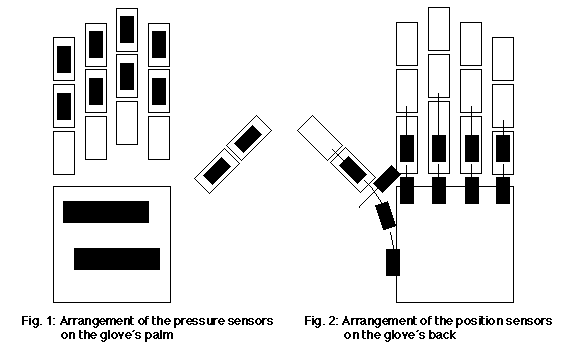The TU-Berlin SensorGlove
- Technical Description -
Frank Hofmann / Jürgen Henz
7/12/1995
1. Introduction
The TU Berlin SensorGlove was developed at the institute for
Real-Time Systems and Robotics of the computer science department at
the Technical University of Berlin. It was part of the project
"Anthropomorphic Robot Hand", in which it was developed in the
framework of a student and diploma thesis. It was shown at the
Hanover Industrial Fair in 1993, arousing widespread interest. The
improved second prototype was presented at the CeBIT 1995.
The patented glove is used as a computer input device for human
grasping movements and hand gestures. It is equipped with
different types of sensors enabling highly precise measurements
(cf. Technical Data, Section 5). A closer description follows
below.
2. General Description
The first prototype of the TUB-SensorGlove consists of two main
parts:
- of the actual glove device measuring the movements of the user's
hand and the pressure distribution during grasping (for this,
twelve position sensors are fastened to the glove's back and
twelve pressure sensors are attached to its palm); and
- of a controller digitizing the received signals. It provides a
standard RS-232 serial interface for transmitting the preprocessed
data to arbitrary host computers.

The twelve capacitive pressure sensors are placed on the glove's
inside (cf. Fig. 1). Two sensors per finger and two on the palm
sense the pressure distribution when an object is grasped.
The position sensors are fastened to the glove's back. As one can
observe in Fig. 2, ten sensors measure finger flexion and two
additional sensors obtain the thumb rotation. Though all the
thumb's joints are measured, bending values are captured only for
two joints of each of the other four fingers. By this, most finger
movements can be characterized in sufficient detail. If needed,
further sensors may be attached to additionally measure finger
splaying and flexion of the other four topmost joints.
The method of measurement (the position sensors are inductive
length encoders) ensures high resolution and mechanical robustness
(=> no maintenance). Their resolution is substantially higher than
that of hitherto available commercial products, as e.g. the
DataGlove(TM) by VPL-Research.
Controller and sensors are connected by auxiliary circuitry. The
controller digitizes the measured signals and groups the results
into data tuples, whereafter they are sent to other computers via
a serial interface.
The first SensorGlove was made from cotton to enable comfortable
wearing over extended periods of time.
The second prototype, as displayed at the Hanover CeBIT 1995, is
an improved version of the first glove. An external controlling
device is no longer needed, as a microcontroller is included on
the glove. The glove can communicate with other computers directly
via the integrated RS 232 serial interface.
The sensors were miniaturized and their electronics improved.
Special new sensors measuring the glove's movements in space allow
its use completely independent from any fixed location (external
3D-reference points are not needed).
The second prototype is made from Lycra so that the sensors are
held in place firmly on the fingers without decreasing the usage
comfort.
3. Applications
Its high accuracy and excellent mechanical robustness predestine
the TUB-SensorGlove for application in many areas, as e.g.:
- cyberspace and virtual reality
- telerobotics (remote control of robots in space / at other
locations which are difficult to access for human beings)
- (remote) control of technical devices with easy-to-learn
gestures
- intuitive control of complex simulations
- control of GUIs (graphical user interfaces ) or e.g. CAD systems
- use as an universal input device for computers
- control of electronic musical instruments or music workstations
/ input device for analytical or artistic purposes
- medical applications (glove controlling 3D-visualizations of
medical images / using the glove in diagnosis and therapy of
motoric diseases, especially of the human hand)
- facilitating communication between deaf-mute or otherwise
disabled and non-disabled people (gestures are recorded with the
glove and translated by a computer into text or speech)
4. Current Work
The second prototype presented at the CeBIT 1995 is already
extremely useful in daily research work. One goal for the
currently commencing development of the third prototype is to
improve the glove's functions especially for applications in
gesture language research.
Goals are:
- Further miniaturization of the electronics;
- Increasing the measurement rate to 100 measurement tuples /
second;
- The optional capacitive pressure sensors are to be replaced by
pressure sensors based on resistive films possessing less size and
weight;
- Enhancing the spatial movement recognition systems's resolution
with more sensitive sensors;
- Different glove sizes (small, medium, large) as well as a
left-handed version.
5. Preliminary Technical Data
- Glove
- Material:
Lycra / Elastan
- Weight (with electronics):
approx. 150g
- Position Sensors
- Number:
12 (max. 24)
- Measurable degrees of freedom:
12 (max. 20)
- Angular Resolution:
(0.1 -) 1 degrees
- Accuracy in bit:
8 (dynamically adjustable)
- Pressure Sensors
- Number:
12 (optional)
- Range of measurement in grams:
approx. 1 ... > 5.000 (nonlinear response characteristic)
- Accuracy in bit:
8
- Hand Movement Sensors
- Number:
3 (optional 6)
- Accuracy in bit:
8 (optional 16)
- Hardware
- Interface:
RS-232, max. 19.200 baud, 3-wire (TxD, RxD, GND)
- Supply voltage:
5V
- Supply current:
approx. 200mA
Typical measurement rates for some sensor configurations (rates
are dynamically adjustable):
Sensors / Tupel Size [bytes] / Measurement Rate [tuples per second] *)
12x Position / 12 / 83
12x Position, 12x Pressure / 24 / 42
12x Position, 12x Pressure, 3x Hand movement / 27 / 37
*) Typical duration of one measurement: approx. 1ms (as the
measurement accuracy is dynamically adjustable, shorter periods of
measurement are possible)
6. Contact
Technische Universität Berlin
Institut für Technische Informatik
Sekretariat EN10
Einsteinufer 17
D-10587 Berlin
Last change: Friday, 03-Nov-1995
Back to the homepage of
Real-Time Systems (Prozessdatenverarbeitung, PDV)

